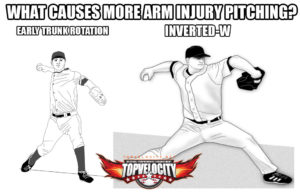 Don't kill the messenger! I am bringing this case study, from MedStar Washington Hospital Center, to the baseball community for the purpose of educating the public. I know there will be those who may take this opportunity to attack me personally for doing this because it goes against their approach to coaching pitchers in this game. I am not affiliated with this study, I am just sharing the information.
Don't kill the messenger! I am bringing this case study, from MedStar Washington Hospital Center, to the baseball community for the purpose of educating the public. I know there will be those who may take this opportunity to attack me personally for doing this because it goes against their approach to coaching pitchers in this game. I am not affiliated with this study, I am just sharing the information.
The value of this study is to understand that the most significant link to arm injury comes from not giving the arm time to load properly. If you have read my last article on the 3 Biomechanics of the lower half that give the arm the proper amount of time to load while also increase pitching velocity then I would highly recommend that you read this revolutionary information on preventing pitching injury before continuing here.
In this article, we will look at this study and its discovery of why early trunk rotation is more damaging to the arm than the inverted-w. We will also talk about how to prevent early trunk rotation with better hip to shoulder separation.
Early Trunk Rotation VS Inverted W for Injury Prevention
Before we dive into the results of this study let's first define these two biomechanical components being compared.
Inverted-W
Defined as hyperabduction of both the throwing and non throwing shoulder combined with internal rotation, occurs shortly after hand separation during the early cocking phase of the throwing motion and has been associated anecdotally with injury risk in pitchers. Compared with a standard throwing motion, the throwing arm in this position has to travel a greater distance to arrive in the vertical position by the time the trunk begins rotating toward home plate. Failure of the throwing arm to arrive in the vertical position before the trunk begins to rotate has been postulated to cause excessive forces in the arm (1).
Early Trunk Rotation
This is starting trunk rotation before the front leg has landed and stabilized. This dissipates some of the potential energy needed to generate a given throwing velocity and has been shown to increase valgus torque at the elbow (1).
The purpose of this study was to determine whether inverted-W arm positioning or early trunk rotation was associated with upper extremity injury requiring surgery for starting Major League Baseball (MLB) pitchers from a single season.
Here are the results from the study:
Inverted-W positioning was not associated with significantly increased risk of surgery using risk analysis (hazard ratio estimate, 1.30; 95% CI, 0.79-2.14). The presence of early trunk rotation was associated with significantly increased risk of surgery (hazard ratio, 1.69; 95% CI, 1.02-2.80).
Based on video analysis of MLB pitchers and on surgery data from publicly available databases, significantly elevated risk of injury requiring surgery was found with early trunk rotation but not with the inverted-W throwing position. Our findings suggest that early trunk rotation raises concerns that warrant the attention of athletes and physicians and that the inverted-W throwing position does not represent a clear area of concern for possible injury with the intense, repetitive stresses of throwing.
How to Prevent Early Trunk Rotation with 3X Pitching
If you have problems with early trunk rotation, it is an extreme challenge to fix and I highly recommend you use the 3X Pitching Velocity Program to get the job done. The 3X Pitching Velocity Program focuses on hip to shoulder separation which is the only way to fix early trunk rotation. To learn more about reducing early trunk rotation watch this instructional video below.
Inverted-W Early Trunk Rotation Reference:
- Wiemi A. Douoguih,*† MD, Donald L. Dolce,‡ MD, and Andrew E. Lincoln,§ ScD, MS - Early Cocking Phase Mechanics and Upper Extremity Surgery Risk in Starting Professional Baseball Pitchers - Investigation performed at the Department of Orthopaedic Surgery, MedStar Washington Hospital Center, Washington, DC, USA


Brent,
You should use Jason Fraser as your model for the arm motion of the high velocity pitcher. A 95MPH guy in his day, he perfectly demonstrates the throwing arm mechanics you teach (including the arm stall).